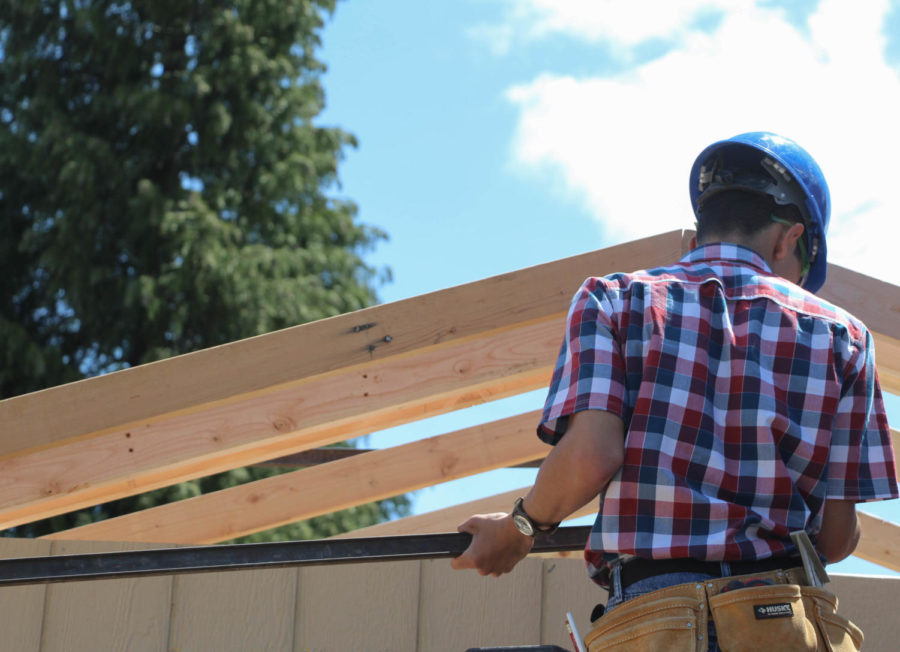When Office of Public Instruction (OSPI) Superintendent Chris Reykdal imagined the new CTE pathways in action, he imagined classes in which students could work hands-on and develop skills that they could then transfer into a career right out of high school. Today, the two-year interdistrict carpentry program at MTHS does just that.
Math class, in most people’s eyes, consists of rows of desks, a teacher in front of the room and students with a textbook or a worksheet solving problems. However, it takes only one visit to the carpentry classroom at MTHS to see a different way of learning entirely.
While students are gaining a math credit by taking the class, their days do not consist of math worksheets or sitting at desks. Each day, they work to develop carpentry skills, working in a team to build tiny homes from the ground up.
The concept for the class began long ago, when the Lynnwood Rotary Club began a partnership with Edmonds College.
“From my understanding, the Lynnwood Rotary Club started this program 48 years ago,” carpentry instructor Tony Wilson said. “They started and created this program for students to build duplexes through the classroom so they could leave the classroom with an understanding of how to build a house.”
Then, not too long ago, the Edmonds School District (ESD) brought the program to MTHS, making it an interdistrict program allowing students from other high schools to take the class, too. However, a new aspect was implemented into the program. Instead of building duplexes, ESD students began developing their carpentry skills by building tiny homes, right on campus.
“This program didn’t always have the tiny house aspect to it. It’s a fairly new part of this program, so that’s also why I’m really excited about it,” Wilson said. “I get to be a part of that process and put my own stamp on it.”
Wilson began teaching the class in the beginning of the 2021-22 school year. Throughout his time teaching, his students began building two tiny homes of their own, while also finishing an inherited tiny home that had not been completed from the previous year’s group of students due to the pandemic.
When Wilson and his first-year carpentry students inherited the tiny home, it had only been sheathed, meaning that all of the plywood was still on it. As a result, instead of learning how to build a house from the beginning, students put on the door, worked on the flooring, interior walls, insolation, roofing and worked to put the finishing touches on it.
“I’m really grateful for my first-year students this year, because to start learning carpentry on that level instead of learning from the ground up is harder,” Wilson said.
Although the process may have been a bit more difficult, Wilson’s students were more than up for the challenge. The inherited home is set to be fully complete before the end of the school year, and Wilson hopes that the other two will be close, too. Once complete, the homes will be donated to the Seattle Low Income Housing Institute.
“We donate these tiny homes to this program that provides transitional housing for families in struggle, or people that maybe need a place to live,” Wilson said. “It’s not intentional for the tiny houses to be permanent living situations, but providing space for families or people to get back into our communities and hopefully empowering them to make bigger steps and have their own space in the near future.”
For the students, knowing that the work they are doing is directly making an impact on the community has been incredibly motivating.
“Somebody will live in these [tiny homes] eventually, and it will hopefully bring a positive impact to their lives and be able to help them better themselves,” senior Cody Snow said. ”It feels really good to be able to come here every day and know that you’re not just building something that might get thrown away or not used.”
However, before the building can begin, students must first learn the basics. Therefore, the beginning of the year is devoted to working together as a class to get comfortable with the tools and procedures that carpenters need on the job each and every single day.
First, they learn about the importance of different types of safety equipment. Then, they begin learning to use hand tools.
After the class as a whole can demonstrate that they have the skills and abilities to use hand tools, Wilson moves on to power tools, which include chop saws, skill saws and table saws. He then creates simple assignments to teach his students how to read a tape measure, how to read a speed square and how to handle the basic tools used on the jobsite every day.
Many items are shipped to MTHS throughout the school year. Among them are carpentry materials, including 16 feet of lumber and full sheets of plywood. After students have demonstrated their ability to use the tools safely and efficiently, Wilson begins to help them read blueprints so that they can start cutting the material into the dimensions they will need to begin the building process.
“We get shipments of materials at the school in very large dimensions,” Wilson said. “I let our students start from there, and I help them learn how to read blueprints so that they can then cut the lumber to dimensions and then put together the tiny house.”
However, the class’s pacing depends heavily on the students. Wilson makes an effort to ensure that everyone is on the same page, and students learn to work together throughout the entirety of the process.
According to Wilson, a tiny home could be built in approximately three months, but there is no set timeline for his class, and the pacing depends on the size of his classes and their collective learning speed.
“We can probably build tiny houses in three months, but it also depends on the speed of learning of the group, so it can vary from year to year,” he said.
Throughout the 2021-22 school year, Wilson has taught all first-year carpentry students. Therefore, they have worked to cultivate their carpentry skills while building tiny homes on campus. Next year, however, Wilson will combine his first and second-year students to begin building a duplex from the ground up, approximately 10 minutes away from MTHS.
“The first year is all about learning how to feel confident and comfortable with hand tools, power tools and using that confidence to build a tiny house,” Wilson said. “The hope and the intention is that when you come back and you take your second year, you are ready to go to work off site at our duplex.”
Thanks to this carpentry program, students thinking about a career in construction can begin working in the industry as early as the summer after their first year with the program. Some students, like senior Izrael Carbajal, joined the class for that exact reason.
“I wanted to learn how to build stuff, and I want to do this as a career, so I wanted to try it out to see if I liked it or not,” he said.
Others, like Snow, don’t necessarily want to work in the construction field after high school. Instead, they hope that the skills they learn in this program will help them with their own personal projects some day.
Snow will be playing baseball at Wenatchee Valley College, and is thinking about taking biology. However, he said he still will utilize the skills he has learned through the carpentry program in years to come.
“I really wanted to be able to take this class and learn more hands-on about carpentry, and maybe be able to build my own house one day,” he said.
The 2021-22 school year was both Carbajal and Snow’s first year with the carpentry program, and both said some of the most valuable skills they have learned in the class center around the correct way to do the work.
“I’d say that learning about stairs and how to make stairs has been a really important skill I’ve learned, and some of the basic safety things, like code requirements that you have to learn about while building, too,” Snow said. “It’s a lot easier to be able to do something, but to do it the right way is definitely important, and that’s something we definitely learn in this class.”
Wilson, considered an industry expert because of his many years of experience with carpentry, has been an excellent resource for them.
“Our teacher, Tony, has been doing a great job of helping everybody and making sure that you know what you’re doing, and when you do something wrong, it’s not negative feedback. It’s something you can improve on and learn, so I’ve really appreciated that about this class,” Snow said.
However, the journey that brought Wilson to this point was a circuitous one. Wilson grew up in a family running a karate school, and since he could walk, he was participating in martial arts.
He was introduced to carpentry early on, taking summer jobs in the industry in his high school years. However, he convinced himself that he didn’t want to go down the carpentry path.
“When I was in middle school and high school, I was being told that I can’t be a carpenter and I should actually go into computers, because there won’t be any future jobs for carpentry,” he said.
So, he explored other options, at one point thinking he wanted to go into business. However, the more he explored that path, the more he realized he didn’t like the way working in sales made him feel.
While he was trying to figure out which route he wanted to take, he kept coming back to carpentry, landing an apprenticeship with a company in Ballard called Foss Maritime where he helped build boats for the coast guard from the ground up. As that company slowly began to dwindle, Wilson soon found himself working part time, which he did not want to do.
“It was the first time in my whole life I had ever had to work only part time on employment, and I just was not ready to live that way,” he said.
So, he left, moving to Colorado with the dream of starting his own martial arts school there. However, his time with Foss Maritime, as well as his studies of political science in college had started a question in his head. He wanted to know how one could live small, and also, how houses came together.
When he got to Colorado, he found himself building houses from the ground up with just one other person to help.
“After putting pieces together in Foss Maritime with the boats, I really wanted to know how houses came together,” he said.
When his friend sent him the job description for the carpentry teaching position in the ESD, Wilson was all in.
“When I heard about this program specifically building tiny houses and donating them to transitional living in Seattle, it got me really excited, because I felt like for the first time, I could use my skill set to make a difference,” he said.
Additionally, Wilson is excited about this program because of the impact it can have on students’ careers. He hopes that they can figure out what they want to do much faster than he was able to as a result of their experiences working hands-on in the trade.
“The most exciting part of this, to me, is the fact that you can walk out of high school with a career if you want to,” he said. “And if you don’t want to do any kind of trade, these skills still can come in handy if you want to do a personal project for yourself or your family.”










